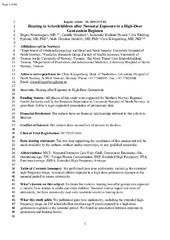| dc.contributor.author | Hemmingsen, Dagny | |
| dc.contributor.author | Mikalsen, Camilla | |
| dc.contributor.author | Rydland Hansen, Alexander | |
| dc.contributor.author | Fjalstad, Jon Widding | |
| dc.contributor.author | Stenklev, Niels Christian | |
| dc.contributor.author | Klingenberg, Claus | |
| dc.date.accessioned | 2021-02-24T12:32:13Z | |
| dc.date.available | 2021-02-24T12:32:13Z | |
| dc.date.issued | 2020-01-31 | |
| dc.description.abstract | <p>OBJECTIVE: To assess the association between gentamicin exposure in the neonatal period and hearing in school age.
<p>METHODS: This study included children exposed to a high-dose (6 mg/kg) gentamicin regimen as neonates (2004–2012), invited for follow-up at school age, and a healthy age-matched control group. We assessed hearing with pure tone audiometry including the extended high-frequency (EHF) range. Outcomes were average hearing thresholds in the midfrequencies (0.5–4 kHz) and the EHFs (9–16 kHz). The measures of gentamicin exposure were cumulative dose and highest trough plasma concentration. We used linear regression models to assess the impact of gentamicin exposure, and other peri- and postnatal morbidities, on hearing thresholds.
<p>RESULTS: A total of 219 gentamicin-exposed and 33 healthy-control children were included in the audiological analysis. In the gentamicin cohort, 39 (17%) had a birth weight <1500 g. Median cumulative doses and trough plasma concentrations were 30 (interquartile range 24–42) mg/kg and 1.0 (interquartile range 0.7–1.2) mg/L, respectively. Median hearing thresholds for the midfrequencies and the EHFs were 2.5 (0 to 6.3) dB hearing level and −1.7 (−5.0 to 5.0) dB hearing level, both of which were within the normal range. In an adjusted analysis, increasing hearing thresholds were associated with lower birth weight and postnatal middle-ear disease but not level of gentamicin exposure. After adjusting for birth weight, there was no difference in hearing threshold between the gentamicin-exposed cohort and healthy controls.
<p>CONCLUSIONS: Exposure to a high-dose gentamicin regimen in the neonatal period was not associated with an increase in hearing thresholds in schoolchildren being able to complete audiometry. | en_US |
| dc.identifier.citation | Hemmingsen, D., Mikalsen, C., Rydland Hansen, A., Fjalstad, J.W., Stenklev, N.C. & Klingenberg, C. (2020). Hearing in schoolchildren after neonatal exposure to a high-dose gentamicin regimen. <i>Pediatrics, 145</i>(2), e20192373. | en_US |
| dc.identifier.cristinID | FRIDAID 1821586 | |
| dc.identifier.doi | 10.1542/peds.2019-2373 | |
| dc.identifier.issn | 0031-4005 | |
| dc.identifier.issn | 1098-4275 | |
| dc.identifier.uri | https://hdl.handle.net/10037/20594 | |
| dc.language.iso | eng | en_US |
| dc.publisher | American Academy of Pediatrics | en_US |
| dc.relation.ispartof | Hemmingsen, D.E. (2024). Neonatal risk factors for hearing impairment. (Doctoral thesis). <a href=https://hdl.handle.net/10037/35300>https://hdl.handle.net/10037/35300</a>. | |
| dc.relation.journal | Pediatrics | |
| dc.rights.accessRights | openAccess | en_US |
| dc.rights.holder | Copyright 2020 The Author(s) | en_US |
| dc.subject | VDP::Medical disciplines: 700::Clinical medical disciplines: 750::Pediatrics: 760 | en_US |
| dc.subject | VDP::Medisinske Fag: 700::Klinisk medisinske fag: 750::Pediatri: 760 | en_US |
| dc.title | Hearing in schoolchildren after neonatal exposure to a high-dose gentamicin regimen | en_US |
| dc.type.version | acceptedVersion | en_US |
| dc.type | Journal article | en_US |
| dc.type | Tidsskriftartikkel | en_US |
| dc.type | Peer reviewed | en_US |


 English
English norsk
norsk